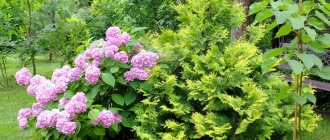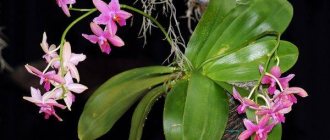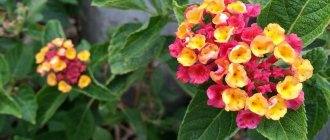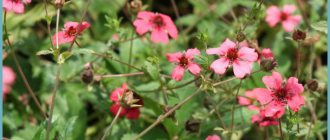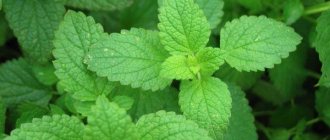- November 14, 2018
- Flowers
- Alexander Nedashkovsky
An orchid is a flower whose beauty is admired. There is hardly a person who will not like it. However, many housewives are in no hurry to purchase a capricious plant, believing that it is a lot of trouble. Actually this is not true. In our article we will talk about how to grow an orchid at home. This task is doable. Not only professionals, but also novice flower growers can handle it.
Selection of pots
Before you start talking about how to grow an orchid at home, you need to figure out which plant containers you should choose. Housewives most often prefer transparent plastic containers or clay pots. Which option is best? Of course, the choice is yours. But it is worth considering the fact that orchids often wither and get sick in clay containers. It is believed that the culprits in the death of the plant are the pots. Orchids are not quite ordinary plants, and therefore the conditions for their maintenance are special. According to experts, excess moisture accumulates in clay pots, and the roots of the plant adhere tightly to the walls. In addition, they are completely deprived of sunlight, and this is destructive for them. All these shortcomings provoke rotting of the root system, which leads to the death of the plant. If you want to succeed in growing orchids at home, it is better to use transparent containers.
Experts recommend choosing transparent plastic pots. Surely you have noticed that these are the vessels that florists use. In such containers, the roots are not compressed; they have plenty of light and space to develop. In addition, plastic pots are often equipped with a special drain for water, and the roots have the opportunity to breathe. Such containers create the most optimal conditions for the orchid to live. This is their advantage. Currently, in professional stores and garden centers you can find many pots designed for growing orchids at home. For beginners, such containers are an ideal option, as they will allow you to avoid many mistakes in flower care.
Difficulties in growing orchids
The orchid's buds and leaves fall off
Perhaps your orchid is not getting enough light or moisture. Humidify the air in the room, move the pot closer to the window, and eliminate drafts. Another reason for an orchid’s leaves to fall may be its proximity to ripe fruits: some of them, for example, apples, emit ethylene, which is very harmful to flowers. A friend of mine had such a case: the children were eating in the bedroom where there are orchids and plums, and in the morning the plant dropped several buds. Although it happens that orchids grow in the kitchen, where there are a lot of all kinds of products, and they feel great. In a word, depending on your luck, it’s better to play it safe and not leave fruit near them.
The leaves of the orchid began to ripple
or their edges have wrinkled. Perhaps the room is too hot, the orchid should feel a temperature difference between day and night of approximately 8 degrees.
Orchid roots peeking out of a flowerpot
It’s okay, it’s just time for the flower to move to a larger pot. But if the roots of the orchid dry out or rot, then urgent measures need to be taken.
Orchid leaves are limp
despite regular watering. Most likely, you overwatered your orchid! Or the pot is too narrow, and the root system of the flower is compressed. Another likely reason is too generous watering with long breaks.
Orchid doesn't bloom
Despite all your efforts, the orchid does not want to bloom. Most likely, the orchid needs the so-called “heat stress”, that is, the same temperature difference between day and night, which should be 8-10 degrees difference. Or maybe your flower just needs a rest.
And finally, a few more words in favor of these graceful and beautiful indoor plants. Orchids on the windowsill are also aromatherapy. The Pleione maculata orchid smells like apples, the Bulbophyllum picctuatum smells like watermelon, and the Cychnoches pentadactylon orchid smells like chocolate!
- Kalanchoe medicinal
In addition, according to the teachings of Feng Shui, orchids stimulate the creative functioning of the brain and help get rid of depression. And dark red orchids supposedly cure their owner of laziness and apathy.
Reproduction by dividing rhizomes
How to grow a baby orchid? You can get a new plant by dividing the bush. This simple propagation method can be used for any variety of orchid. You need to take a large plant, remove it from the pot, carefully separating the rhizomes from the soil and walls. The roots of the culture are very delicate and fragile, so you need to work with them carefully. You need to divide them with a sharp knife, cutting them into the required number of pieces.
Each of them must have at least three well-developed bulbs. Next, the sections are sprinkled with charcoal for disinfection. Children are placed in separate containers. They require standard care.
Species growing in the post-Soviet space
No one brought orchids from expeditions to the Soviet Union for planting and breeding. They have grown on our territory for many centuries. There are known historical facts of their use by the Zaporozhye Cossacks. Both amulets and dried food.
The nature of the post-Soviet space is rich in orchids. A total of 419 species from 49 genera. There are about 130 species in Russia, Belarus and Ukraine alone. And almost all of them are in the Red Book. These are not tropical beauties. They belong to terrestrial species . Take a look at the most famous ones.
Lady's slipper.
Little white shoe.
Lyubka bifolia.
Orchis. Cuckoo's tears.
Fingerroot.
Dremlik.
Comperia. Grows only in Crimea. On the limestones of the southern coast.
Propagation by seeds
Many novice gardeners are interested in whether it is possible to grow an orchid at home from seeds. This method is very complicated. It is possible to grow a full-fledged plant in this way only in a laboratory environment. The fact is that the seeds are very small and they develop due to fungal mycorrhiza and root sponge, from which all the useful substances come. The orchids we grow at home do not have nutritious tissue. Therefore, the necessary environment must be created artificially. Of course, you can try to grow a plant hydroponically, but in this case not only the orchid itself will develop, but also mold fungi. And by killing fungal forms, we will destroy the flora. In other words, a flower can be propagated by seeds only under sterile conditions, which can only be provided in laboratory conditions. Growing one orchid will take from 1.5 to 5 years. Some varieties may bloom only after 10 years. Therefore, this method is impractical.
How to grow flowers at home?
The unique thing about orchids is that they can be grown in different ways. In addition to the classic planting in a flower pot, you can cultivate phalaenopsis:
- in vases;
- in a closed system;
- in water;
- in the greenhouse.
In glass vases
For beginners in floriculture, it is better to immediately abandon this method, since it requires some experience and knowledge of the characteristics of the plant. More experienced gardeners choose this cultivation method because it is aesthetically pleasing. A vase with an orchid looks sophisticated and delicate.
The nuances of growing an orchid in a vase:
- It is best to give preference to a flowerpot with a wide base and a narrow neck. This will give additional stability to the flower, and also provide enough space for the development of its root system.
- When planting, do not immerse the plant completely in the container. You need to hang it with special devices at the level you need. Just be sure to leave enough space for air exchange in the root system so that the roots do not “suffocate.”
- If you already have experience working with orchids, then you can try to protect the roots from rotting using drainage made from inert materials. But such a drainage system is only suitable for tropical plant varieties grown without soil mixture.
In a closed system
Another original way of cultivating orchids, used by experienced gardeners. It is believed that a closed system for growing these plants is more effective.
When growing phalaenopsis in a closed system, you need to pay special attention to the watering regime.
The nuances of growing orchids in a closed system:
- There are no drainage holes or drains in the planting container, while all the liquid that flows to the plant and nourishes it is located at the drainage level.
- You need to plant orchids in a glass or plastic container (it all depends on the temperature in the room). When choosing a glass container, make sure that it will not get too cold in the winter when placed on the window.
- Drainage is poured into the bottom of the planting pot, and a layer of soil is added on top. Larger pieces of bark are laid directly on the drainage layer.
- When planting, try to leave the root collar of the orchid above the soil mixture.
- During watering, you need to carefully ensure that the liquid level remains at the level of the drainage layer. Too much water will lead to rotting of the roots and death of the flower, and too little will lead to drying out of the root system.
In water
An interesting method of cultivating orchids, which is based on the principles of hydroponics. The method of growing a flower in water is also called the open method.
The open system is suitable for a limited number of orchid subspecies. In this case, the selected plant should not be in a dormant period and have sufficient moisture in the root system.
The following types of orchids feel best in water:
- Dendrobium;
- Zygopetalum;
- Phragmipedium;
- Mormodes;
- Phalaenopsis (develops much more slowly than with traditional cultivation);
- Oncidium;
- Miltoniopsis.
The nuances of growing orchids in an open system:
- For planting, you need to choose a transparent container, the volume of which corresponds to the volume of the root system.
- The roots will not be in the soil, but in the water, so the water temperature should be slightly below room temperature (by 2-3 degrees).
- The fluid will need to be changed every day. Add fresh water so that it completely covers the root system.
- The temperature and lighting conditions must correspond to the characteristics of the plant.
- Fertilizers are applied throughout the entire growing season. The concentration of solutions should be reduced by 2-3 times.
Video about the features of growing orchids in water:
In the greenhouse
Cultivating phalaenopsis in a greenhouse is possible in apartment conditions . Most often, in spacious rooms it is difficult to achieve the required temperature and humidity levels, so gardeners resort to the help of a homemade mini-greenhouse, which can be created from scrap materials.
Almost any website dedicated to gardening has a lot of options for greenhouses in which you can grow orchids.
The greenhouse is useful not only for growing orchids, but also for its resuscitation. It can help even if the plant for some reason is left completely without a root system.
The design will help to constantly maintain the desired temperature and humidity level, which is an important condition for the complete rehabilitation of phalaenopsis.
Propagation by cuttings
Is it possible to grow an orchid using cuttings? Some varieties are quite successfully propagated by apical cuttings. But for this, the plant must have certain distances between the nodes. To work with the plant, you must use a sterile knife, with which the cutting is cut approximately in the middle (at an angle of 45 degrees). Fresh cuts are treated with crushed charcoal. The resulting cutting is planted in a new pot. In the future, with proper care, the young plant will grow quickly. Experienced gardeners recommend using this method only for fast-growing varieties.
Life cycle
Despite the fact that orchids differ in varieties and species, their life cycle is long - on average from 60 to 80 years. But there are also long-livers in nature, whose age can exceed a hundred years; it is unlikely that it will be possible to grow such houses.
Where does Monstera grow in nature - the plant’s homeland
At the same time, the plants are unpretentious and quite easy-going. They are not afraid of temperature changes, and the lack of light, on the contrary, is perceived as beneficial.
Note! Since the times of ancient China, it has been grown in the homes of noble families, passed down by inheritance, which also indicates the longevity of orchids.
Reproduction by children
Continuing the conversation about how to properly grow orchids, it is worth saying that experienced gardeners use children for propagation. This method is the simplest and gives good results. It can be used several months after the plant has finished flowering.
The best time is February-June. New buds appear in the leaf axils. However, before this, the flower stalks that emerge under the old leaves must grow. On them you can find two types of buds and buds. Some buds give life to young peduncles, while others help produce children.
Growing in temperate latitudes
Despite the huge abundance of tropical beauties, orchids are also found in temperate latitudes.
Pollenhead
The plant is found in dry shady forests of mountainous regions. To obtain nutrients, it forms a symbiosis with mushrooms. Propagated by root shoots and seeds. There are small-flowered and large-flowered species.
Pollenhead.
Interesting! Flowers have no nectar.
Kokushnik
Small flowers appear only after 5 years of life and have a subtle vanilla aroma.
The root system looks like a system of tubers that interact with the mycelium.
Kokushnik.
Dremlik
Dremlik marsh prefers marshy areas . Forms inflorescences with small beautiful flowers. It blooms in mid-summer and attracts insects with its intoxicating smell.
It is a light-loving plant, so it can only be found in open areas.
Dremlik swamp.
Calypso bulbous
A delicate orchid that loves solitude, grows in cool, damp areas . Prefers open forests.
It blooms in early spring and easily withstands late frosts. It produces a single leaf, which dies after flowering.
Calypso bulbous.
Anacamptis pyramidalis
The plant belongs to the orchis species . It has wintering tubers and a long stem reaching a height of up to half a meter.
It reproduces by seeds, of which a lot is produced. They are similar in size to dust particles and are spread by the wind.
Anacamptis pyramidalis.
Comperia compera
It has unusually shaped flowers. Tendrils extending from the petals hang down. Because of its appearance, the orchid is loved by flower growers and florists.
Distributed in Crimea.
Comperia compera.
Traunsteiner spherical
Grows on the damp mountain slopes of the Caucasus and Crimea . It is also found in other regions of Russia and Ukraine.
Traunsteinera is spherical.
The necessary conditions
How to grow an orchid correctly? At home, you can propagate only an adult healthy plant that has a developed root system. The orchid should have 4 large leaves. For propagation, use a peduncle that is at least 1.5 years old.
Experienced florists believe that with sudden changes in temperature, new shoots begin to form. To achieve this effect, the night temperature must be at + 17 degrees, and the day temperature at + 30. In addition, it is necessary to maintain a high level of humidity. On the hottest days, you can spray or install a tray nearby. At night, the air should remain cool. If humidity levels are low, the plant may die.
First mentions
How does pineapple grow in nature and at home?
The first mentions of orchids are found in ancient Chinese scrolls. Confucius himself wrote about them, comparing their smell with the words of close friends. In Ancient Greece, the orchid was used to achieve success in love affairs, as well as for various rituals.
For your information! It is known that in the 4th century. BC e. The botanist Theophrastus mentioned these flowers, calling them plants that are used to prepare antidepressants.
There is a legend that in the 2nd century. BC e. The orchid helped the Empress of China give birth to children, which she and her husband had dreamed of for several years. At the same time, the Chinese character for orchid appeared.
Important! Orchid pollen has been found in rocks more than 80 million years old.
in the 1st and 2nd centuries. n. e. Chinese scientists have written many scientific works about the healing properties of these plants. There is also information that in the 2nd century. Mexicans used the flower to prepare national drinks. In subsequent centuries, many books and monographs were written about orchids in different parts of the planet.
Independent appearance of children
Under certain conditions, babies on an orchid can appear independently. If you find that shoots have appeared on your peduncle, do not touch them. It is necessary to observe them until two young leaves appear on the children. After this, aerial roots will begin to form. As soon as the roots reach five centimeters, the children can be separated. If you want to get a young plant, but there are no new shoots, stimulation is necessary. To do this, you will have to carefully remove the scales so as not to disturb the dormant buds. Cytokinin ointment is applied on top. If you don't have one, you can use an alternative method. Wet moss is placed on top, wrapped in polyethylene. In the future, the orchid must be kept warm. After the babies appear, the film can be removed.
Hormonal paste for stimulation can be purchased at the store, but you can prepare it yourself. For this you will need: 1 ml of water, 10 mg of kinetin, 1 g of lanolin. All components must be mixed until smooth. The correct paste is white. During the propagation process, usually only one shoot appears, and to avoid this, you can place the plant in a greenhouse, in which it is necessary to maintain a temperature of at least +28 degrees. The orchid should remain in such conditions for up to five days. Afterwards it should be treated with paste.
Where were orchids brought to Russia from?
The first wave of interest in the sensational flowers came to Russia in the 19th century. Flowers were brought from England and Germany for the royal family and noble families. The second wave took over the country after the Second World War, when greenhouses of famous German collectors were brought to Russia. At the end of the forties, the era of industrial cultivation of orchid representatives began in Russia.
For your information! It was during the orchid fever that a new profession was invented - plant hunter.
Child care
Babies usually appear on a peduncle or at the base of a rosette. Wherever they hatch, it is necessary to wait for aerial roots to appear. After this, the young plants are planted in separate pots, since they take a lot of energy from the mother plant. The cuttings of the children are processed, after which they are planted in containers with fine soil, in which root regrowth will occur. Soon the lower leaves will turn yellow and fall off - this is a normal reaction of the plant. While the root system is forming, the orchid can be placed in a greenhouse. If time passes and there are very few young roots, then you will have to stimulate the plant. To do this, you can use the drugs “Epin”, “Kornevin”, “Heteroauxin”. You can speed up the process of root formation by using a water reservoir placed near the plant.
Distribution in the world
When purchasing a beautiful flower in a store, we cannot always even imagine the habitats of orchids. Where do they grow?
There are many types of orchids - about 35 thousand. They are so different. And their natural habitats are far from identical. Even very different. So what is their difference?
Representatives of orchids surprise not only with their beauty and originality. But also with its ability to survive in different climates:
- Hot and harsh;
- Rainy and dry;
- Forests and steppes;
- Mountains and plains.
Continents are easier to list. And we can say that all continents. Except for one thing - Antarctica. But it will take a long time to name the countries. Next we will name some.
Tropical epiphytes
The word epiphyte itself means a plant growing on another plant. Or attached to another plant - phorophyte. This is how they grow:
- On trees (branches and trunks);
- On stumps and snags;
- In the crevices of stones;
- And even on steep cliffs.
Such plants live off moisture, air and bark residues. Their roots are also called aerial:
- With their help they are attached;
- These roots absorb moisture from the air and wet surfaces of the tree;
- And they also participate in the process of photosynthesis.
Herbaceous species of temperate latitudes
Can such an orchid grow in the ground? Let's just say that they cannot do without soil . They have underground rhizomes or tubers. They find a peculiar soil - breathable and moisture-permeable pieces of bark, stone chips, roots.
Some species are found on the surface of the earth in layers of fallen leaves, branches and bark of trees, overgrowth of moss and small stones. Such orchids have few leaves. Quite often - only one.
Conditional division by climatic latitudes
The diversity of orchids required some analysis and systematization. They are divided into five subfamilies:
- Herbaceous perennials. Each of them includes many tribes: Apostasiaceae;
- Cypripediaceae.
- Vanilla.
- Epidendral.
- Orchids or Orchidaceae.
There is also a division by climatic zones and territories. It's more conditional. And includes four groups:
- Tropics. Bright and ventilated places near rivers. On the slopes of the mountains. Epiphytic species grow predominantly: Coast of Africa, South and Central America, eastern and northern Australia;
- Adjacent areas of the Amazon and Congo rivers.
- Foothills of the Himalayas;
- Highlands and arid zones. With their temperature variations (hot days and cold nights), they are suitable for many types of terrestrial orchids. And some epiphytic ones. And they grow near rivers and reservoirs.
- North America;
Obtaining cuttings
You can get new plants from cuttings. For this you will need faded flower stalks. They are cut off at the base and divided into cuttings, each of which should be 3-4 cm long. There should be a dormant bud in the center of each. Fresh sections are treated with charcoal, after which the blanks are placed in a greenhouse with damp sphagnum moss. Under the right conditions, cuttings germinate very quickly.
You can get children in another way. To do this, after flowering, the flower stalks are cut off and placed in water with fertilizers. This will awaken the sleeping buds from which babies will appear.
When and how the plant was first brought to Europe
The plant was brought to Europe in the second half of the 18th century. It was brought by travelers from South America. According to legend, a botanist from Great Britain received a gift from his fellow seeker in the form of a shriveled orchid. He planted it, and the beautiful flowers that appeared later became the beginning of the plant's popularity. However, until the orchid took root in Europe, about a hundred years passed.
Botanists conducted many experiments in greenhouses until they were able to grow the first flower. The orchid quickly became popular; having such a flower at home was considered a sign of luxury, and the demand for it grew rapidly. The popularity of the flowers increased even more when rumors emerged that the orchid was an aphrodisiac. Many people added the tubers of the plant to love drinks and believed in its miraculous power.
Rich collectors were willing to buy plants for huge rewards, so money hunters went into the rainforests and overcame many obstacles to get these precious signs of luxury. However, many were unable to bring flowers safely to Europe, since the long journey often became disastrous for them.
Orchids were loaded by the ton onto ships for profit, and for this reason, many species of plants died during the orchid fever. Over time, a greenhouse suitcase was invented that let in light, moisture and protected from direct sunlight. However, while some were hunting, others were looking for ways to domesticate the Orchid family. And already in the 19th century. botanists began to experimentally grow new varieties.
Reproduction by peduncles
Some varieties of orchids can be propagated by flower stalks, in particular this applies to phalaenopsis. To do this, they are cut off and placed in a plastic bottle with the neck cut off. Water is poured into the container and an activated carbon tablet is added. The lower part of the peduncle should be immersed in liquid by 4-5 centimeters. To produce babies, flower growers recommend awakening dormant buds. You need to use a sharp object to cut off the semicircular scale that covers the bud. The top should be treated with cytokinin paste. In the future, the ointment on the cut must be renewed every week. The water in the container also needs to be changed once every seven days. If everything is done correctly, within a month the kidney should wake up and a baby will form from it.
Transfer
An orchid cannot be replanted during the flowering period, since it will have to spend a lot of energy on flowering and rooting at the same time, and this can lead to serious consequences. It is best to replant the plant immediately after flowering. This happens mainly in spring or autumn.
Note! The flower needs to change the substrate and pot size every 3 years.
In order for the orchid to successfully grow and develop further, you must follow the step-by-step instructions for replanting:
- First, the orchid needs to be removed from the pot. If you can’t pull out the flower, you can crush the pot or even cut it.
- The roots need to be freed from the old bark; if any piece has grown to the flower, then it’s not a big deal.
- It is imperative to remove rotten or dead roots, but it is better not to touch the healthy part.
- Before planting, the flower must be dried. This process takes on average 2 hours.
- Phalaenopsis is planted in the soil and not watered for 5 days. Also, it is not recommended to apply fertilizing during the first month.
Transfer
Blue orchids
Very often, novice gardeners wonder how to grow a blue orchid. At home, you can color white phalaenopsis using special dyes. Under no circumstances should you use ink - it contains harmful substances that destroy the plant.
At home, the plant is colored by watering. This method is the simplest, but not very effective. In industrial conditions, injections of a special pigment into peduncles or roots are used. The method is dangerous because it can lead to the death of the plant.
Diseases and pests
The most common causes of bacterial, fungal and viral problems are insect infestation, plant injury, or handling of unsterile tools combined with suboptimal growing conditions.
Viruses
The most unpleasant and irreparable thing is the infection of orchids with viruses. Plants can be infected with viruses, but this does not appear externally. None of the known anti-virus remedies help. In this case, there is only one way out - to destroy the plant.
Fungal diseases
The reasons for the spread are too humid an environment, lack of air exchange and fresh air. Auxiliary means: in case of local limited infection, parts of the plant are removed, fungicides are used and cultivation conditions are improved.
Fungal disease
Bacteriosis
Bacteriosis occurs whenever water accumulates on leaves or leaf axils for a long time. Plant tissue suffers from this. Avoid stagnation of water on various parts of the plant.
Pests
Pests can be divided into three groups:
- Group 1: woodlice, silverfish and nematodes live on plant material and do not actually harm the plant. Control method: reduce watering, keep the plant a little drier and collect pests by hand.
- Group 2: Snails feed on plant parts or whole plants. The most effective antidotes, prevention and collection.
- Group 3: sucking pests cause the most damage. These include primarily aphids. They multiply quickly and can cause a lot of damage. Auxiliary means: the use of insecticides and special spraying of plants. Insects have a favorite place on the underside of leaves. It is best to apply any edible oil with a cotton swab to the insect colony, then the aphids will suffocate. Do not rub with your fingers under any circumstances, this will distribute the juveniles and eggs over the entire area of the leaves!
Thrips parasites
Differences between domestic and wild varieties
Amateur flower growers and experienced breeders have long loved phalaenopsis for its exotic appearance and character. Interestingly, modern botany already knows more than 5,000 artificially bred varieties . Of course, they differ significantly from their “wild” ancestors or have practically nothing in common with them.
Perhaps the most striking and obvious difference is the direction of growth. Cultivated orchids do without vertical support and grow upward well.
As for the size of the flowers, the “domestic” representatives have much larger flowers, although they are inferior in terms of the number of them on the peduncle. The flower stalks of wild phalaenopsis are literally strewn with dozens of flowers , forming huge hanging clusters.



